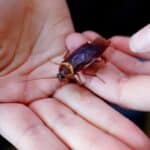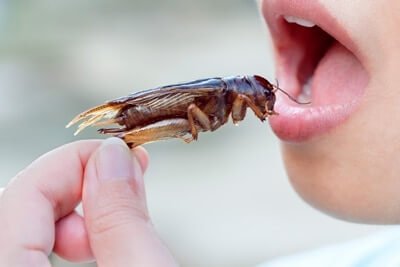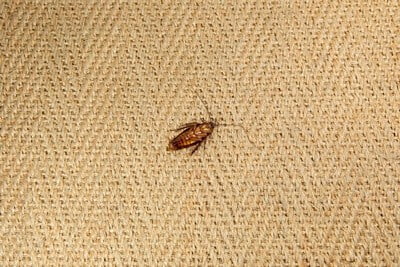Cockroaches are an unpleasant pest at the best of times. But when they settle into your mattress, it can feel as if there’s no escaping them. If they do get into your mattress, you’re at risk of getting sick from the harmful bacteria they carry. They may even enter your ears or mouth while you sleep.
Cockroaches rarely live in mattresses as it’s too dangerous. However, cockroaches feed off food crumbs, loose hairs, dead skin, and bodily fluids, which they find both within and on top of mattresses. That’s why you’re more likely to see a random roach or two crawling over your mattress or bed frame at night. If there are rips or tears in your mattress, they may move into them because they like the feeling of tight spaces surrounding their bodies.
You can keep cockroaches away from your mattress by using natural pest repellents, such as catnip, or by putting a light dusting of diatomaceous earth around your bed. Vacuuming also removes visible cockroaches.
Do Cockroaches Infest Mattresses?
As mentioned, it’s rare for cockroaches to infest mattresses. They’re more likely to hide behind headboards and bedside furniture.
That being said, this all depends on the scale of the infestation. If the colony becomes too large and the pests start competing for food and shelter, they’ll live anywhere that provides protection and access to food and water. Unfortunately, mattresses offer these things.
Cockroaches are also opportunistic feeders. They’re drawn to mattresses because they feed on loose hair strands, dead skin, and sweat produced by humans as they sleep. According to the Journal of Investigative Dermatology, hair contains sebum and lipids that attract cockroaches. The oilier and greasier the hair strands, the better. Hair isn’t a cockroach’s favorite thing to eat, but it can sustain them for a while.
The only plus side to cockroaches living in mattresses is that they don’t feed off human blood, so they won’t bite you as you sleep.
Can Roaches Get In Your Mattress?
Cockroaches have strong chewing mandibles that can tear through fabric. However, it’s unusual for them to bite through material unless it has food and drink stains or body fluids for cockroaches to feast on.
If there are tears in your mattress, cockroaches can get through them and may choose to hibernate inside where it’s warm. Cockroaches can fit through gaps that are 1/4 of their own standing height and only 3mm wide. A study by Proceedings of the National Academy of Sciences found that cockroaches compress their bodies by 40-60%.
Cockroaches are also thigmotropic, which means they like the feeling of tight spaces surrounding their bodies. They’re highly responsive to touch and enjoy living in mattresses if the space feels tight enough.
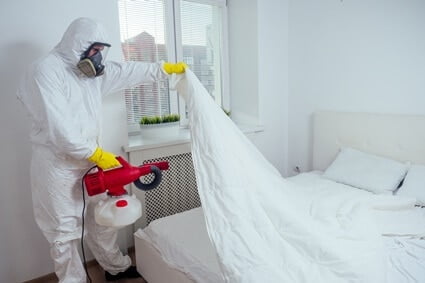
Do Roaches Crawl on Beds?
Cockroaches are more likely to crawl on beds than live in them. Even though mattresses are warm and snug, humans sleep on them every night, which cockroaches recognize as a threat and too close to danger. Cockroaches are smart enough to stay away and find somewhere quieter to reside.
However, if you have a habit of eating while sitting in bed, cockroaches will sniff out the crumbs and food spills and head towards it for sustenance. Once they’ve eaten, they’ll crawl back to their original hiding place, sometimes taking the food they find with them for other cockroaches in the colony.
Unfortunately, you may be unlucky enough to wake up with a cockroach crawling on your bed. Cockroaches spread disease-causing bacteria, so you don’t want them anywhere near your skin. If a roach crawls over you while you sleep, you’re at risk of contracting:
- Typhoid fever
- Diarrhea
- Dysentery
- Cholera
- Listeriosis
- Salmonellosis
- E. coli
There’s also a slight (but very real) chance of cockroaches crawling into your mouth and ears as they explore your bed. If one gets inside your ear, it could get stuck.
Can Roaches Live in Box Springs?
Cockroaches are more likely to live in box springs than mattresses because they’re dark and provide better protection from direct human contact. However, whether they live in box springs or not comes down to whether they’re:
- Easy access in and out
- Located near to food and water
- Better hiding spaces elsewhere
Box springs also offer potential entry points into the mattress, making it more likely to have a cockroach infestation in your bed later on down the line. Another thing to watch out for is under-bed clutter, which makes it easier for cockroaches to hide.
An easy way to keep cockroaches away from box springs is to wrap silicone tape around the bottom of your bedposts, which should stop cockroaches from being able to climb. You should also keep your bed area as clutter-free as possible.
Do Roaches Lay Eggs in Mattresses?
Cockroaches lay their eggs in warm, dark, tight spaces to keep their offspring safe. The inside of a mattress makes the perfect location for their ootheca (the cockroach egg casing), but roaches are more likely to store their eggs where humans don’t reside, such as behind kitchen cupboards or in hard-to-reach spaces where they won’t be found or touched. That being said, they may hide their eggs between mattress joins or under the bed where you’ve placed the mattress.
If you’re buying a second-hand mattress, be sure to check for any splits or rips that cockroaches can enter through. Even if you don’t see live roaches, that doesn’t mean there aren’t eggs inside. Clean the mattress as thoroughly as you can and vacuum it before using it to minimize the risk of cockroach eggs. The worst thing that can happen is they hatch overnight and crawl on you while you sleep.
How To Prevent Cockroaches in Mattresses
Once cockroaches get into your mattress, they’re a nightmare to get out. That’s why you’ll want to keep them away instead. These steps should work:
Don’t Eat In Bed
One of the most effective ways to ensure cockroaches don’t get into your mattress is to avoid eating food in bed. Cockroaches feed on even the tiniest food particles and spills. Even if you can’t see or feel them, they’re likely there. Crumbs are enough to attract particles, so always eat away from your bed to minimize the risk of attracting the pests.
Wear Clean Pajamas
We experience changes to our body temperature at night, which means we sweat in our sleep. If you don’t wash your pajamas often enough, bacteria will begin to break down protein molecules within the sweat on your pajamas, causing an unpleasant body odor. Cockroaches are attracted to this and will head towards your clothes, crawling over your bed to get to your bodily fluids.
Use Natural Pest Repellents
There are several natural pest repellents that cockroaches hate. If you use them in your bedroom, cockroaches will stay away and ignore your mattress. A quick and easy repellent method is to put a shallow dish filled with coffee granules near your bed. Peppermint oil and catnip are other excellent cockroach repellents and can keep them away from your bedroom for good.
Tuck In Bedding
Don’t let your bedding drag along the floor – tuck it in so that cockroaches can’t use it to climb onto your mattress. While cockroaches can get onto the mattress by other means, it makes it so much harder if they have nothing to cling onto, and they’re more likely to move on from your mattress to find another hiding space.
Diatomaceous Earth
If you’re worried about cockroaches getting into your mattress, sprinkle a light dusting of diatomaceous earth around your bed. Once the cockroaches come into contact with the powder, it’ll scratch their exoskeletons and draw out essential fats and oils. They’ll live on for a short while before dehydrating to death.
Boric acid also works to eradicate cockroaches, but it’s a more potent method of pest control. If you have allergies or sensitivities, it may irritate your skin if you come into direct contact with it. It’s also not as safe to use around animals.
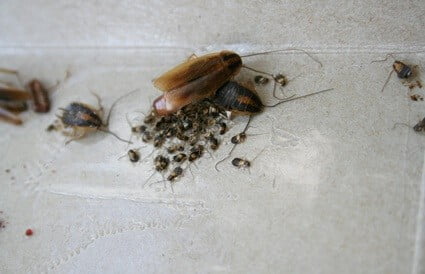
What Bugs Are Found in Mattresses?
Unfortunately, cockroaches aren’t the only creatures that are potentially lurking in the depths of your mattress. You also have to keep an eye out for these bugs:
Bed Bugs
Bed bugs are the most common mattress-dwelling bugs. They’re typically dark yellow, red, or brown and leave red, itchy sores from where they feed off human blood. They can be seen with the naked eye, but they hide in the daytime, making them difficult to spot.
Fleas
Fleas live in warm environments, so mattresses make the perfect home. They come from pets and hide between sheets, inside pillowcases, and within mattresses. They’re relatively easy to kill if you place your bedding on a hot wash cycle and vacuum both sides of your mattress.
Dust Mites
Dust mites are only just visible to the naked eye. They live in mattresses and feed on dead skin, pollen, bacteria, and pet dander. They also live in upholstered furniture and curtains and can trigger allergies and asthma.
Carpet Beetles
Carpet beetles are also fond of mattresses. They’re commonly mistaken for bed bugs because they look similar, but they have distinctive wings that set them apart. Unlike bed bugs, they don’t consume human blood, but they eat animal-based fabrics, such as wool, fur, and leather.
Bat Bugs
Bat bugs are blood-sucking parasites that hide in mattresses, box springs, and bed frames. They look and spread in a similar way to bed bugs and leave skin feeling itchy and sore.
You must do everything you can to protect your living space by making your mattress as unhabitable as possible. Here’s how to keep cockroaches away during your sleep.


